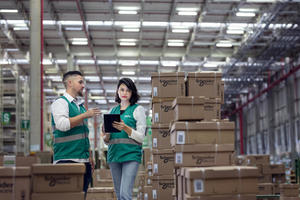
 |
Charlotte Stonestreet
Managing Editor |
| Home> | AUTOMATION | >Handling & Logistics | >Unlocking logistics with open automation |
Unlocking logistics with open automation
10 June 2025
Dave Sutton looks at how adopting an open platform can help bridge the gap between legacy assets and cutting-edge robotics in the logistics sector

LOGISTICS HAS always been a critical element of business operations, and for that reason the sector has been at the forefront of technology, acting as an early adopter for robotics and automation. This has created a challenge where there is a broad mix of OT and IT alongside new and legacy assets. Joining the dots throughout these disparate systems requires a revolutionary approach to automation that will drive innovation in logistics and deliver value and support UK businesses as they scale and compete on the global stage.
Adopting an open platform based on the IEC 61499 standard for Universal Automation establishes a single digital thread that bridges the gap between legacy assets and cutting-edge robotics. It also serves to build a foundation for futureproofing, enabling logistics teams to remain agile to market demand while improving in sustainability throughout the supply chain.
Making logistics sense
Warehouse and logistics operations are being tasked with handling higher demand, even in the wake of a growing skills and labour shortage, coupled with the pressure of reducing energy consumption across the board. While these may seem like significant challenges to overcome, there is an opportunity for logistics professionals to seize a competitive advantage, regardless of how complex their material handling application.
Open automation redefines logistics for end users looking to optimise operations as well as the OEMs and system integrators that serve the industry. Open automation means that plug and produce software is independent from the hardware it runs on, empowering everyone to deploy best-in-class technology whether upgrading an existing facility, increasing warehouse size, or building a greenfield logistics centre.
It also provides access to operational data. All of logistics can explore the capabilities and elements of digitalisation most beneficial to them without any integration roadblocks.
Logistics operators that have successfully opened the flow of data in a facility will find sustainability-improving activities without any changes to the existing infrastructure:
- Real-time monitoring and control of all logistics assets (including surrounding elements like HVAC & lighting) will highlight any unnecessary consumption that can be rectified to minimise energy usage without sacrificing performance.
- Depending on the logistics application, unexpected downtime of machines will often lead to wasted energy or materials. Addressing maintenance concerns before they lead to downtime not only minimises this waste, but it also extends the lifecycle of assets. This previously would not have been possible for legacy assets that didn’t have the correct digital capabilities at point of installation but this barrier is removed so that legacy assets can be brought up to modern standards.
- Again, depending on the logistics application, an open automation platform will help logistics communicate directly with the production facility so that data-driven insights can better anticipate demand, and automatically adjust inventory level requests to reduce waste from unused products. Optimising inventory management helps logistics operations contribute to a more sustainable supply chain.
Robotics for resilience
With automation integration challenges solved, logistics managers are free to explore next-generation robotics that will help to mitigate the impact of the skills gap and improve overall efficiency. New robotic solutions can physically integrate with existing systems and the workforce.
Logistics has always required a different level of agility than applications with set specific runs, so a modular design means logistics can apply the right robotics at the right time. Modularity can also optimise the use of space, which remains a challenge for the sector as warehouse space is at an all-time high following the rise of e-commerce. Building on open automation means that even the most advanced robotics with independent movers, for example, can be integrated seamlessly with existing operations while enabling different configurations on the same line.
Whether a logistics team is looking to optimise their main hub or fulfil demand for faster delivery by adding warehouse space close to the consumer, open automation and robotics are tools to help them handle any variety of products with the required precision.
Dave Sutton is product marketing manager for industrial automation at Schneider Electric
- Next generation PAC has open Ethernet technology at its core
- Variable Speed Drives: digitising the industry
- Future-ready I/O solution
- Schneider Electric names Ai Automation first UK&I Robotics Partner
- Optimising safety in hydrogen processes
- Smart remote terminal unit enhances OT security
- Schneider opens new UK state-of-the-art manufacturing plant
- Modular circuit protection range
- Scoring sustainability goals
- The Future of PLCs in packaging




















